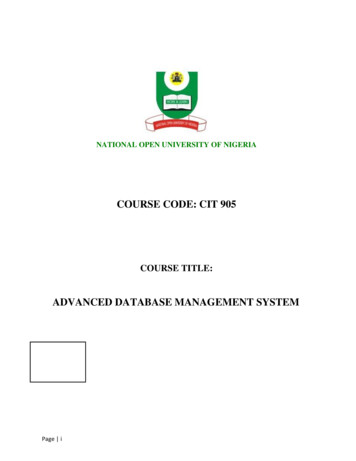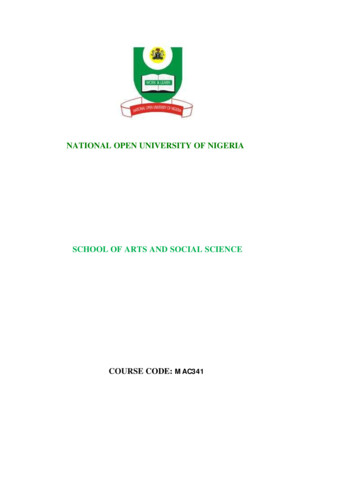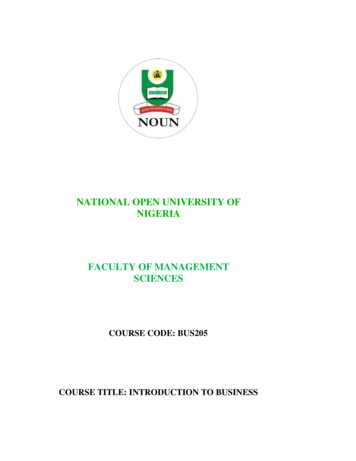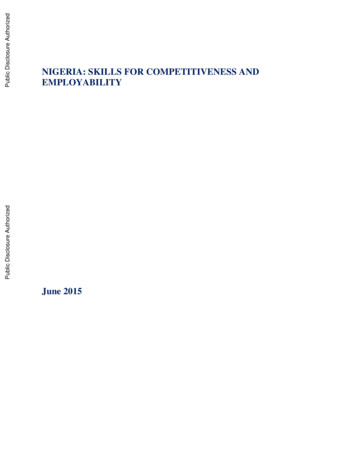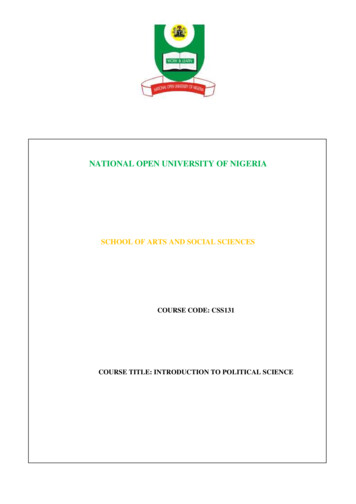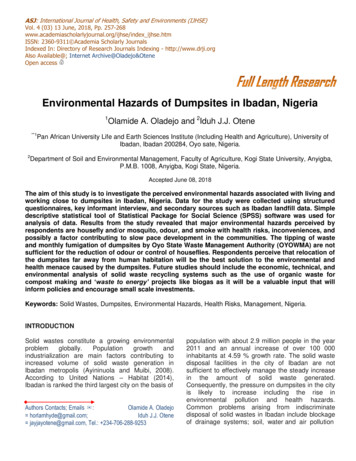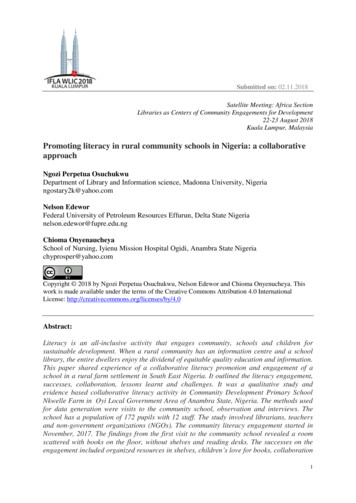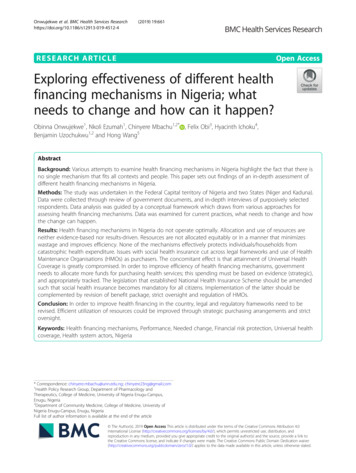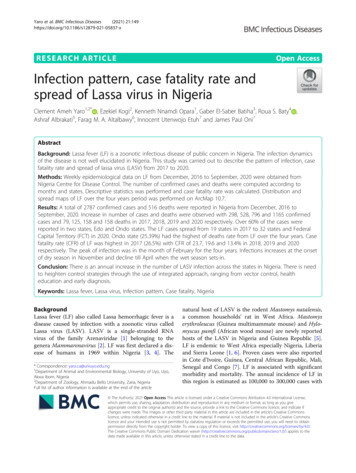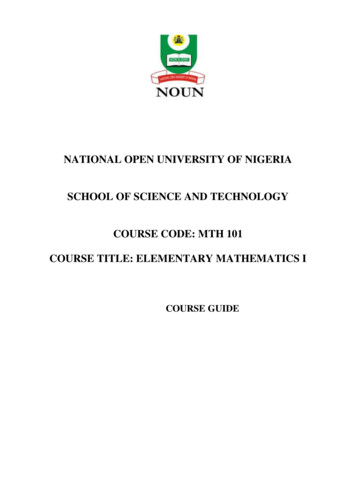
Transcription
NATIONAL OPEN UNIVERSITY OF NIGERIASCHOOL OF SCIENCE AND TECHNOLOGYCOURSE CODE: MTH 101COURSE TITLE: ELEMENTARY MATHEMATICS ICOURSE GUIDE
Course Developer/WritersEster OmonayinBase University, AbujaandBabatubde OshoNational Open University of NigeriaContent EditorIshola Christy,Olorunnisola ToyinandOgundipe. OlalekanDepartment of Mathematics,National Open University of NigeriaCourse CoordinatorsIshola Christy,Olorunnisola ToyinandOgundipe. OlalekanDepartment of Mathematics,National Open University of Nigeria
National Open University of NigeriaHeadquarters14/16 Ahmadu Bello WayVictoria IslandLagosPublished in 2015 by the National Open University of Nigeria, 14/16 Ahmadu Bello Way, VictoriaIsland, Lagos, Nigeria National Open University of Nigeria 2015This publication is made available in Open Access under the Attribution-ShareAlike4.0 (CC-BYSA 4.0) license (http://creativecommons.org/licenses/by-sa/4.0/). By using the content of thispublication, the users accept to be bound by the terms of use of the National Open University ofNigeria Open Educational Resources Repository: http://www.oer.nou.edu.ngThe designations employed and the presentation of material throughout this publication do notimply the expression of any opinion whatsoever on the part of National Open University of Nigeriaconcerning the legal status of any country, territory, city or area or of its authorities, or concerningthe delimitation of its frontiers or boundaries. The ideas and opinions expressed in this publicationare those of the authors; they are not necessarily those of National Open University of Nigeria anddo not commit the Organization.How to Reuse and Attribute this contentUnder this license, any user of this textbook or the textbook contents herein must provide properattribution as follows: “First produced by the National Open University of Nigeria” and include theNOUN Logo and the cover of the publication. If you use this course material as a bibliographic reference, then you should cite it as follows:“Course code: Course Title, National Open University of Nigeria, 2014 athttp://www.nou.edu.ng/index.htm# If you redistribute this textbook in a print format, in whole or part, then you must include onevery physical page the following attribution:"Download for free at the National Open University of Nigeria Open Educational ResourcesRepository at http://www.nou.edu.ng/index.htm#). If you electronically redistribute part of this textbook, in whole or part, then you must retain inevery digital format page view (including but not limited to EPUB, PDF, and HTML) thefollowing attribution:"Download for free, National Open University of Nigeria Open Educational ResourcesRepository athttp://www.nou.edu.ng/index.htm#)
Course GuideCourse Code: MTH 101Course Title: ELEMENTARY MATHEMATICS I
IntroductionIntroductionMTH 101 - Elemetary Mathematics I is designed to teach you how mathematics couldbe used in solving problems in the contemporary Science world. Therefore, thecourse is structured to expose you to the skills required in other to attain a level ofproficiency in Science, tecnology and Engineering Professions .What you will learn in this CourseYou will be taught the basis of mathematics required in solving s c i e nt i f i cproblems.Course AimThere are ten study units in the course and each unit has its objectives. Youshould read the objectives of each unit and bear them in mind as you gothrough the unit. In addition to the objectives of each unit, the overall aims ofthis course include:(i)(ii)(iii)(iv)To introduce you to the words and concepts in ElementarymathematicsTo familiarize you with the peculiar characteristics inElementary mathematics.To expose you to the need for and the demands of mathematics inthe Science world.To prepare you for the contemporary Science world.Course ObjectivesThe objectives of this course are: To inculcate appropriate mathematical skills required inScience and Engineering. Educate learners on how to use mathematical Techniques insolving real life problems. Educate the learners on how to integrate mathematical models inSciences and Engineering.Working through this Course{ You have to work through all the study units in the course. There are twomodules and ten study units in all.Page 1
Course MaterialsMajor components of the course are:1. Course Guide2. Study Units3. Textbooks4. CDs5. Assignments File6. Presentation ScheduleStudy UnitsThe breakdown of the three modules and eight study units are as follows:MODULE ONEUnit 1 Elementary Sets TheoryUnit 2 Basic Set OperationsUnit 3 Set of NumbersMODULE TWOUnit 1 : Real Sequence And SeriesUNIT 2 : Qadratic equationsUnit 3 : Mathematical InductionMODULE THREE:UNIT !: COMPLEX NUMBERSUNIT 2 CIRCULAR MEASURERecommended Texts*{Seymour, L.S. (1964). Outline Series: Theory and Problems of Set Theoryand related topics, pp. 1 – 133.*Sunday, O.I. (1998). Introduction to Real Analysis (Real-valued functions of areal variable, Vol. 1)*Pure Mathematics for Advanced Level By B.D Bunday H Mulholland1970.*Introduction to Mathematical Economics By Edward T. Dowling.*Mathematics and Quantitative MethodsEconomics. By Stephen P. Shao. 1976.forBusinessandPage 2
* Mathematics for Commerce & Economics By Qazi Zameeruddin &V.K. Khanne1995.*Engineering Mathematics By K. A Stroad.*Business Mathematics and Information Technology. ACCA STUDYMANUAL By. Foulks Lynch.* Introduction to Mathematical Economics SCHAUM‟S Out linesAssignment File{ In this file, you will find all the details of the work you must submit to your tutorfor marking. The marks you obtain from these assignments will count towards the finalmark you obtain for this course. Further information on assignments will be found inthe Assignment File itself and later in this Course Guide in the section on assessment.Presentation ScheduleThe Presentation Schedule included in your course materials gives you the importantdates for the completion of tutor-marked assignments and attending tutorials.Remember, you are required to submit all your assignments by the due date. Youshould guard against falling behind in your work.AssessmentYour assessment will be based on tutor-marked assignments (TMAs) and a finalexamination which you will write at the end of the course.}Exercises TMAS{ Every unit contains at least one or two assignments. You are advised to workthrough all the assignments and submit them for assessment. Your tutor will assessthe assignments and select four which will constitute the 30% of your final grade.The tutor-marked assignments may be presented to you in a separate file. Justknow that for every unit there are some tutor-marked assignments for you. It isimportant you do them and submit for assessment. }Page 3
Final Examination and Grading{ At the end of the course, you will write a final examination which willconstitute 70% of your final grade. In the examination which shall last for two hours,you will be requested to answer three questions out of at least five questions.Course marking SchemeThis table shows how the actual course marking as it is broken down.AssessmentMarksAssignmentsFour assignments, Best three marks ofthe four count at 30% of course marksFinal ExaminationTotal70% of overall course marks100% of course marksHow to Get the Most from This CourseIn distance learning, the study units replace the university lecture. This is one of thegreat advantages of distance learning; you can read and work through speciallydesigned study materials at your own pace, and at a time and place that suits youbest. Think of it as reading the lecture instead of listening to the lecturer. In the sameway a lecturer might give you some reading to do, the study units tell you whento read, and which are your text materials or set books. You are provided exercisesto do at appropriate points, just as a lecturer might give you an in-class exercise. Eachof the study units follows a common format. The first item is an introduction to thesubject matter of the unit, and how a particular unit is integrated with the otherunits and the course as a whole. Next to this is a set of learning objectives.These objectives let you know what you should be able to do by the time you havecompleted the unit. These learning objectives are meant to guide your study. Themoment a unit is finished, you must go back and check whether you haveachieved the objectives. If this is made a habit, then you will significantly improvePage 4
your chances of passing the course. The main body of the unit guides you throughthe required reading from other sources. This will usually be either from your setbooks or from a Reading section. The following is a practical strategy for workingthrough the course. If you run into any trouble, telephone your tutor. Remember thatyour tutor’s job is to help you. When you need assistance, do not hesitate to call andask your tutor to provide it.In addition do the following:1. Read this Course Guide thoroughly, it is your first assignment.2. Organise a Study Schedule. Design a Course Overview ‟ to guide youthrough the Course”. Note the time you are expected to spend on each unit and how theassignments relate to the units. Important information, e.g. details of your tutorials,and the date of the first day of the Semester is available from the study centre. Youneed to gather all the information into one place, such as your diary or a wallcalendar. Whatever method you choose to use, you should decide on and write in yourown dates and schedule of work for each unit.3. Once you have created your own study schedule, do everything to stay faithfulto it. The major reason that students fail is that they get behind with their coursework. If you get into difficulties with your schedule, please, let your tutor knowbefore it is too late for help.4. Turn to Unit 1, and read the introduction and the objectives for the unit.5. Assemble the study materials. You will need your set books and the unit you arestudying at any point in time.6. Work through the unit. As you work through the unit, you will know what sources toconsult for further information.7. Keep in touch with your study centre. Up-to-date course information will becontinuously available there.8. Well before the relevant due dates (about 4 weeks before due dates), keep in mindthat you will learn a lot by doing the assignment carefully. They have beendesigned to help you meet the objectives of the course and, therefore, will help youpass the examination. Submit all assignments not later than the due date.Page 5
9. Review the objectives for each study unit to confirm that you have achieved them. Ifyou feel unsure about any of the objectives, review the study materials or consult yourtutor.10. When you are confident that you have achieved a unit’s objectives, you can start onthe next unit. Proceed unit by unit through the course and try to pace your study so thatyou keep yourself on schedule.11. When you have submitted an assignment to your tutor for marking, do not wait forits return before starting on the next unit. Keep to your schedule. When theAssignment is returned, pay particular attention to your tutor’s comments, both on thetutor-marked assignment form and also the written comments on the ordinaryassignments.12. After completing the last unit, review the course and prepare yourself for thefinal examination. Check that you have achieved the unit objectives (listed at thebeginning of each unit) and the course objectives (listed in the Course Guide).Tutors and TutorialsThe dates, times and locations of these tutorials will be made available to you, togetherwith the name, telephone number and the address of your tutor. Each assignment willbe marked by your tutor. Pay close attention to the commentsyour tutor might make on your assignments as these will help in your progress. Makesure that assignments reach your tutor on or before the due date.Your tutorials are important therefore try not to skip any. It is an opportunity to meetyour tutor and your fellow students. It is also an opportunity to get the help of yourtutor and discuss any difficulties encountered on your reading. SummaryThis course would train you on the concept of multimedia, production andutilization of it.Wish you the best of luck as you read through this coursePage 6
Course Code:MTH 101Course Title: ELEMENTARY MATHEMATICS IMODULE ONEUnit 1 Elementary Sets TheoryUnit 2 Basic Set OperationsUnit 3 Set of NumbersModule 2 .Error! Bookmark not defined.Unit 1. Error! Bookmark not defined.Unit 2. Error! Bookmark not defined.Unit 3. Error! Bookmark not defined.
MODULE ONEUnit 1 Elementary Sets TheoryUnit 2 Basic Set OperationsUnit 3 Set of NumbersUNIT 1:Elementary SetsTheory1.0 Introduction2.0 Objectives3.0 Main Body3.1 Sets3.1.1 Notation3.1.2 Finite and Infinite sets3.1.3 Equality of sets3.1.4 Null Set3.2 Subsets3.2.1 Proper subsets3.2.2 Comparability3.2.3 Set of sets3.2.4 Universal set3.2.5 Power set3.2.6 Disjoint sets3.3 Venn-Euler diagrams3.4 Axiomatic development of set theory4.0 Conclusion5.0 Summary6.0 Tutor-Marked assignment7.0 References and Further readings
1.0 INTRODUCTIONThe theory of sets lies at the foundation of mathematics. It is a concept thatrears its head in almost all fields of mathematics; pure and applied.This unit aims at introducing basic concepts that would be explained further insubsequent units. There will be definition of terms and lots of examples andexercises to help you as you go along.2.0 OBJECTIVESAt the end of this unit, you should be able to: Identify sets from some given statements Rewrite sets in the different set notation Identify the different kinds of sets with examples3.0 MAIN BODY3.1 SETSAs mentioned in the introduction, a fundamental concept in all a branch ofmathematics is that of set. Here is a definition “A set is any well-defined list,collection or class of objects”.The objects in sets, as we shall see from examples, can be anything: But forclarity, we now list ten particular examples of sets:Example 1.1 The numbers 0, 2, 4, 6, 8Example 1.2 The solutions of the equation x² 2x 1 0Example 1.3 The vowels of the alphabet: a, e, i, o, uExample 1.4 The people living on earth
Example 1.5 The students Tom, Dick and Harry Example1.6 The students who are absent from school Example 1.7The countries England, France and Denmark Example 1.8The capital cities of NigeriaExample 1.9 The number 1, 3, 7, and 10Example 1.10 The Rivers in NigeriaNote that the sets in the odd numbered examples are defined, that is, presented,by actually listing its members; and the sets in the even numbered examplesare defined by stating properties that is, rules, which decide whether or not aparticular object is a member of the set.3.1.1 NotationSets will usually be denoted by capital letters;A, B, X, Y,.Lower case letters will usually represent the elements in our sets:Lets take as an example; if we define a particular set by actually listing itsmembers, for example, let A consist of numbers 1,3,7, and 10, then we writeA {1,3,7,10}That is, the elements are separated by commas and enclosed in brackets {We call this the tabular form of a setNow, try your hand on thisExercise 1.1State in words and then write in tabular form1. A {x} x ² 4²}2. B {x} x – 2 5}}.
3. C {x} x is positive, x is negative}4. D {x} x is a letter in the word “correct”}Solution:1.It reads “A is the set of x such that x squared equals four”. The onlynumbers which when squared give four are 2 and -2. Hence A {2, -2}2.It reads “B is the set of x such that x minus 2 equals 5”. The onlysolution is 7; hence B {7}3.It read “C is the set of x such that x is positive and x is negative”. Thereis no number which is both positive and negative; hence C is empty, thatis, C Ø4.It reads “D is the set of x such that x is letter in the work ‘correct’. Theindicated letters a re c,o,r,e and t; thus D {c,o,r,e,t}But if we define a particular set by stating properties which its elements mustsatisfy, for example, let B be the set of all even numbers, then we use a letter,usually x, to represent an arbitrary element and we write:B {x x is even}Which reads “B is the set of numbers x such that x is even”. We call this theset builders form of a set. Notice that the vertical line “ ” is read “such as”.In order to illustrate the use of the above notations, we rewrite the sets inexamples 1.1-1.10. We denote the sets by A 1, A 2, . A10 respectively.Example 2.1: A1 {0, 2, 4, 6, 8}Example 2.2: A2 {x x² 2x 1 0}Example 2.3: A3 {a, e, i, o, u}Example 2.4: A4 {x x is a person living on the earth}Example 2.5: A5 {Tom, Dick, Harry}
Example 2.6: A6 {x x is a student and x is absent from school}Example 2.7: A7 {England, France, Denmark}Example 2.8: A8 {x x is a capital city and x is in Nigeria}Example 2.9: A9 {1, 3, 7, 10}Example 2.10: A10 { x x is a river and x is in Nigeria} It is easy as that!Exercise 1.2Write These Sets in a Set-Builder Form1.Let A consist of the letters a, b, c, d and e2.Let B {2, 4, 6, 8.}3.Let C consist of the countries in the United Nations4.Let D {3}5.Let E be the Heads of State Obasanjo, Yaradua and JonathanSolution1.A {x x appears before f in the alphabet} {xx is one of the firstletters in the alphabet}2.B {x x is even and positive}3.C {x x is a country, x is in the United Nations}4.D {x x – 2 1} {x 2x 6}5.E {x x was Head of state after Abacha}If an object x is a member of a set A, i.e., A contains x as one of its\elements,then we write: x AWhich can be read “x belongs to A” or ‘x is in A”. If, on the otherhand, anobject x is not a member of a set A, i.e A does not contain x as one of itselements, then we write; x A
It is a common custom in mathematics to put a vertical line “ ” or “ \ ”through a symbol to indicate the opposite or negative meaning of the symbol.Example 3:1: Let A {a, e, i o, u}. Then a A, b A, f A.Example 3.2: Let B {x x is even}. Then 3 B, 6 B, 11 B,14 B3.1.2 Finite & Infinite SetsSets can be finite or infinite. Intuitively, a set is finite if it consists of a specificnumber of different elements, i.e. if in counting the different members of theset the counting process can come to an end. Otherwise a set is infinite. Letslook at some examples.Example 4:1: Let M be the set of the days of the week. The M is finiteExample 4:2: Let N {0,2,4,6,8.}. Then N is infiniteExample 4:3: Let P {x x is a river on the earth}. Although it maybedifficult to count the number of rivers in the world, P is still a finite set.Exercise 1.3: Which sets are finite?1. The months of the year2. {1, 2, 3, . 99, 100}3. The people living on the earth4. {x x is even}5. {1, 2, 3,.}Solution:The first three sets are finite. Although physically it might be impossible tocount the number of people on the earth, the set is still finite. The last two setsare infinite. If we ever try to count the even numbers, we would never come tothe end.20
3.1.3 Equality of SetsSet A is equal to set B if they both have the same members, i.e if everyelement which belongs to A also belongs to B and if every element whichbelongs to B also belongs to A. We denote the equality of sets A and B by:A BExample 5.1 Let A {1, 2, 3, 4} and B {3, 1, 4, 2}. Then A B,that is {1,2,3,4} {3,1,4,2}, since each of the elements1,2,3 and 4 of A belongs to B and each of the elements3,1,4 and 2 of B belongs to A. Note therefore that a set does not change if itselements are rearranged.Example 5.3 Let E {x x²–3x -2}, F {2,1} and G {1,2,2, 1},Then E F G3.1.4 Null SetIt is convenient to introduce the concept of the empty set, that is, a set whichcontains no elements. This set is sometimes called the null set.We say that such a set is void or empty, and we denote its symbol Example 6.1: Let A be the set of people in the world who are older than 200years. According to known statistics A is the null set.Example 6.2: Let B {x x² 4, x is odd}, Then B is the empty set.3.2 SUBSETSIf every element in a set A is also a member of a set B, then A is called subsetof B.More specifically, A is a subset of B if x A implies x B. We denote thisrelationship by writing; A B, which can also be read “A is contained in B”.21
Example 7.1The set C {1,3,5} is a subset of D {5,4,3,2,1}, since each number 1, 3 and5 belonging to C also belongs to D.Example 7.2The set E {2,4,6} is a subset of F {6,2,4}, since each number 2,4, and 6belonging to E also belongs to F. Note, in particular, that E F. In a similarmanner it can be shown that every set is a subset of itself.Example 7.3Let G {x x is even}, i.e. G {2,4,6}, and let F {x x is a positive powerof 2}, i.e. let F {2,4,8,16.} Then F G, i.e. F is contained in G.With the above definition of a subset, we are able to restate the definition ofthe equality of two sets.Two set A and B are equal, i.e. A B, if an only if A B and B A. If A is asubset of B, then we can also write:B AWhich reads “B is a superset of A” or “B contains A”. Furthermore, we write:A Bif A is not a subset of B.Conclusively, we state:1.The null set is considered to be a subset of every set2.If A is not a subset of B, that is, if A B, then there is at least oneelement in A that is not a member of B.22
3.2.1 Proper SubsetsSince every set A is a subset of itself, we call B a proper subset of A if, first, isa subset of A and secondly, if B is not equal to A. More briefly, B is a propersubset of A if:B A and B AIn some books “B is a subset of A” is denoted byB Aand B” is a proper subset of A” is denoted byB AWe will continue to use the previous notation in which we do not distinguishedbetween a subset and a proper subset.3.2.2 ComparabilityTwo sets A and B are said to be comparable if:A B or B A;That is, if one of the sets is a subset of the other set. Moreover, two sets A andB are said to be not comparable if:A B and B ANote that if A is not comparable to B then there is an element in A.which is notin B and . also, there is an element in B which is not in A.Example 8.1: Let A {a,b} and B {a,b,c}. The A is comparable to B, sinceA is a subset of B.Example 8.2: Let R – {a,b} and S {b,c,d}. Then R and S are notcomparable, since a R and a S and c R23
In mathematics, many statements can be proven to be true by the use ofprevious assumptions and definitions. In fact, the essence of mathematicsconsists of theorems and their proofs. We now proof our firstTheorem 1.1: If A is a subset of B and B is a subset of C then A is a subset ofC, that is,A B and B C implies A BProof: (Notice that we must show that any element in A is also an element inC). Let x be an element of A, that is, let x A. Since A is a subset of B, x alsobelongs to B, that is, x B. But by hypothesis, B C; hence every element of B,which includes x, is a number of C. We have shown that x A implies x C.Accordingly, by definition, A C.3.2.3 Sets of SetsIt sometimes will happen that the object of a set are sets themselves; forexample, the set of all subsets of A. In order to avoid saying “set of sets”, it iscommon practice to say “family of sets” or “class of sets”. Under thecircumstances, and in order to avoid confusion, we sometimes will let scriptletters A, B,.Denote families, or classes, of sets since capital letters already denote theirelements.Example 9.1: In geometry we usually say “a family of lines” or “a family ofcurves” since lines and curves are themselves sets of points.Example 9.2: The set {{2,3}, {2}, {5,6}} is a family of sets. Its members arethe sets {2,3}, {2} and {5,6}.Theoretically, it is possible that a set has some members, which are setsthemselves and some members which are not sets, although in any applicationof the theory of sets this case arises infrequently.24
Example 9.3: Let A {2, {1,3}, 4, {2,5}}. Then A is not a family of sets; heresome elements of A are sets and some are not.3.2.4 Universal SetIn any application of the theory of sets, all the sets under investigation willlikely be subsets of a fixed set. We call this set the universal set or universe ofdiscourse. We denote this set by U.Example 10.1: In plane geometry, the universal set consists of all the points inthe plane.Example 10.2: In human population studies, the universal set consists of allthe people in the world.3.2.5 Power SetThe family of all the subsets of any set S is called the power set of S.We denote the power set of S by: 2SExample 11.1: Let M {a,b} Then 2M {{a, b}, {a}, {b}, }Example 11.2: Let T {4,7,8} then 2T {T, {4,7}, {4,8}, {7,8}, {4}, {7},{8}, }If a set S is finite, say S has n elements, then the power set of S can be shownto have 2n elements. This is one reason why the class of subsets of S is calledthe power set of S and is denoted by 2S.3.2.6 Disjoint SetsIf sets A and B have no elements in common, i.e if no element of A is in B andno element of B is in A, then we say that A and B are disjointExample 12.1: Let A {1,3,7,8} and B {2,4,7,9}, Then A and B are notdisjoint since 7 is in both sets, i.e 7 A and 7 B25
Example 12.2: Let A be the positive numbers and let B be the negativenumbers. Then A and B are disjoint since no number is both positive andnegative.Example 12.3: Let E {x, y, z} and F {r, s, t}, Then E and F are disjoint.3.3 VENN-EULER DIAGRAMSA simple and instructive way of illustrating the relationships between sets is inthe use of the so-called Ven-Euler diagrams or, simply, Venn diagrams. Herewe represent a set by a simple plane area, usually bounded by a circle.Example 13.1: Suppose A B and, say, A B, then A and B can be describedby either diagramABABExample 13.2: Suppose A and B are not comparable. Then A and B can berepresented by the diagram on the right if they are disjoint, or the diagram onthe let if they are not disjoint.ABABA26
Example 13.3: Let A {a, b, c, d} and B {c, d, e, f}. Then we illustrate thesesets a Venn diagram of the form:ABacebdf3.4 AXIOMATIC DEVELOPMENT OF SET THEORYIn an axiomatic development of a branch of mathematics, one begins with:1. Undefined terms2. Undefined relations3. Axioms relating the undefined terms and undefined relations. Then, onedevelops theorems based upon the axioms and definitions Example 14:1:In an axiomatic development of Plane Euclidean geometry1. “Points” and “lines” are undefined terms2. “Points on a line” or, equivalent, “line contain a point” is an undefinedrelation3. Two of the axioms are:Axiom 1: Two different points are on one and only one lineAxiom 2: Two different lines cannot contain more than one point in commonIn an axiomatic development of set theory:1. “Element’ and “set” are undefined terms2. “Element belongs to a set” is undefined relation3. Two of the axioms are27
Axiom of Extension: Two sets A and B are equal if and only if every elementin A belongs to B and every element in B belongs to A.Axiom of Specification: Let P(x) be any statement and let A be any set. Thenthere exists a set:B {a a A, P (a) is true}Here, P(x) is a sentence in one variable for which P(a) is true or false for anya A. for example P(x) could be the sentence “x² 4” or “x is a member of theUnited Nations”4.0 CONCLUSIONYou have been introduced to basic concepts of sets, set notation e.t.c that willbe built upon in other units. If you have not mastered them by now you willnotice you have to come back to this unit from time to time.5.0 SUMMARYA summary of the basic concept of set theory is as follows: A set is any well-defined list, collection, or class of objects. Given a set A with elements 1,3,5,7 the tabular form of representing thisset is A {1, 3, 5, 7}. The set-builder form of the same set is A {x x 2n 1,0 n 3} Given the set N {2,4,6,8,.} then N is said to be infinite, since thecounting process of its elements will never come to an end, otherwise itis finite Two sets of A and B are said to be equal if they both have the sameelements, written A B28
The null set, , contains no elements and is a subset of every set The set A is a subset of another set B, written A B, if every element ofA is also an element of B, i.e. for every x A then x B If B A and B A, then B is a proper subset of A Two sets A and B are comparable if A B and B A The power set 2² of any set S is the family of all the subsets of S Two sets A and B are said to be disjoint if they do not have any elementin common, i.e their intersection is a null set.6.0 TUTOR-MARKED ASSIGNMENTS1.Rewrite the following statement using set notation:1.x does not belong to A.2.R is a superset of S3.d is a member of E4.F is not a subset of G5.H does not included D2.Which of these sets are equal: {r,t,s}, {s,t,r,s}, {t,s,t,r}, {s,r,s,t}?3.Which sets are finite?1.The months of the year2.{1,2,3,.99, 100}3.The people living on the earth4.{x x is even}5.{1,2,3.)29
The first three set are finite. Although physically it might be impossible tocount the number of people on the earth, the set is still finite. The last two setare infinite. If we ever try to count the even numbers we would never come tothe end.4. Which word is different from each other, and why: (1) empty, (2) void, (3)zero, (4) null?7.0REFERENCE AND FURTHER READINGSeymour, L.S. (1964). Outline Series: Theory and Problems of Set Theory andrelated topics, pp. 1 – 133.Sunday, O.I. (1998). Introduction to Real Analysis (Real-valued functions of areal variable, Vol. 1)30
UNIT 2: BASIC SET ain Body3.1Set Operations3.1.1 Union3.1.2 Intersection3.1.3 Difference3.1.4 Complement3.2Operations on Comparable Sets4.0C
NATIONAL OPEN UNIVERSITY OF NIGERIA SCHOOL OF SCIENCE AND TECHNOLOGY COURSE CODE: MTH 101 COURSE TITLE: ELEMENTARY MATHEMATICS I COURSE GUIDE. . 14/16 Ahmadu Bello Way Victoria Island Lagos Published in 2015 by the National Open University of Nigeria, 14/16 Ahmadu Bello Way, Victoria
